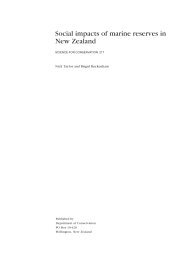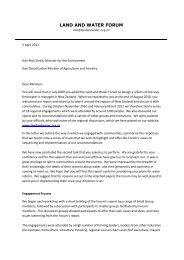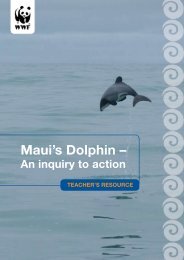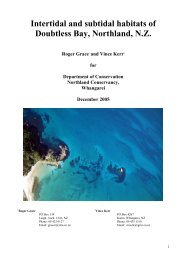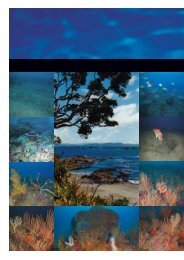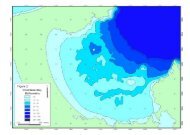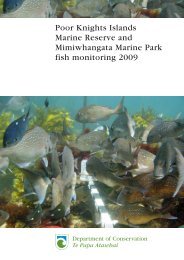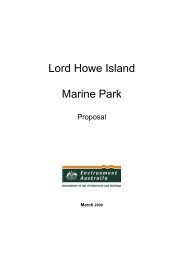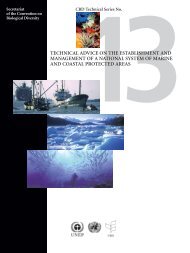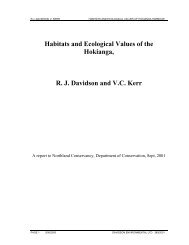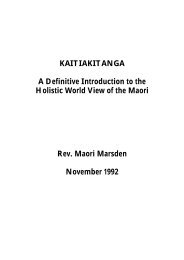WWF Shining a spotlight on the biodiversity of ... - MarineNZ.org.nz
WWF Shining a spotlight on the biodiversity of ... - MarineNZ.org.nz
WWF Shining a spotlight on the biodiversity of ... - MarineNZ.org.nz
You also want an ePaper? Increase the reach of your titles
YUMPU automatically turns print PDFs into web optimized ePapers that Google loves.
Marlborough Sounds<br />
Map ID number:<br />
9<br />
Locati<strong>on</strong>: Cloudy Bay to<br />
Croiselles Harbour, Tasman<br />
Bay<br />
Approximate area: 4,450km 2<br />
Descripti<strong>on</strong> <strong>of</strong> area:<br />
The Marlborough Sounds are a complex<br />
drowned valley system spanning str<strong>on</strong>g gradients<br />
in depth, tidal mixture, temperature, and<br />
wave exposure. As a result <strong>of</strong> <strong>the</strong>se physical<br />
influences <strong>the</strong>re are a wide range <strong>of</strong> habitats,<br />
including stream mouths and large estuaries,<br />
sheltered rocky shores with low algal biomass,<br />
shallow sand and mud habitats, and exposed<br />
eastern shores subject to high wave exposure<br />
and str<strong>on</strong>g tidal currents.<br />
Biological attributes:<br />
Small pelagic fishes, such as sprats (Sprattus<br />
spp.), anchovy (Engraulis australis),<br />
and pilchards (Sardinops neopilchardus) are<br />
abundant in <strong>the</strong> Marlborough Sounds. These<br />
are important prey for seabirds such as shearwaters<br />
and gannets, and for bottlenose, dusky,<br />
and Hector’s dolphins. Estuaries and streams<br />
in <strong>the</strong> area are important for diadromous fishes<br />
(fishes that migrate between fresh and salt<br />
waters). Bryozoan beds at Chetwode, Titi,<br />
Trio, and Rangitoto islands support diverse<br />
assemblages <strong>of</strong> small benthic fishes (including<br />
juvenile commercial species such as blue<br />
cod (Parapercis colias). Large schools <strong>of</strong><br />
planktivores (predominantly butterfly perch<br />
Caesioperca lepidoptera) also live am<strong>on</strong>g<br />
<strong>the</strong> bryozoan beds. Deepwater emergence is<br />
observed at Port Underwood where lantern<br />
fishes, rat tails, and dark ghost sharks (Hydrolagus<br />
novaezealandiae) are found shallower<br />
than in o<strong>the</strong>r regi<strong>on</strong>s. The inner Queen<br />
Charlotte and Pelorus Sounds are spawning<br />
grounds for elephant fish (Callorhinchus<br />
milii). The Marlborough Sounds are <strong>the</strong><br />
sou<strong>the</strong>rn range limit for pink brotula (Brosmodorsalis<br />
persicinus): Queen Charlotte Sound<br />
and Port Hardy are <strong>the</strong> <strong>on</strong>ly sites south <strong>of</strong> East<br />
Cape where this species has been recorded.<br />
Criteria for inclusi<strong>on</strong>:<br />
Dependency for o<strong>the</strong>r species; trophic/functi<strong>on</strong>al<br />
diversity; representati<strong>on</strong> (i.e. across<br />
physical types); extremities <strong>of</strong> range and<br />
adaptati<strong>on</strong> to envir<strong>on</strong>ment; degree <strong>of</strong> disturbance;<br />
special c<strong>on</strong>diti<strong>on</strong>s and specialised<br />
<strong>org</strong>anisms; habitat complexity/diversity.<br />
Status and management:<br />
The Marlborough Sounds are major recreati<strong>on</strong>al<br />
fishing grounds, particularly for blue<br />
cod. However, rocky habitat is limited to a<br />
thin strip around <strong>the</strong> sides <strong>of</strong> most sounds,<br />
which means that overfishing is a problem.<br />
Allowable catches for both commercial and<br />
recreati<strong>on</strong>al fisheries have been reduced in<br />
resp<strong>on</strong>se. In <strong>the</strong> outer sounds and Cook Strait<br />
<strong>the</strong>re is an important commercial and recreati<strong>on</strong>al<br />
hapuku (Polypri<strong>on</strong> oxygeneios) fishery.<br />
There were historical fisheries for this species<br />
inside both sounds.<br />
State <strong>of</strong> informati<strong>on</strong>:<br />
Moderately well studied.<br />
References and fur<strong>the</strong>r reading:<br />
C. Duffy (unpubl. data), Hurst et al. (2000b),<br />
Johnst<strong>on</strong> (1983).<br />
Pegasus Bay/<br />
Canterbury Bight<br />
Map ID number:<br />
10<br />
Locati<strong>on</strong>: Waitaki River to north<br />
<strong>of</strong> Waimakariri River<br />
Approximate area: 22,288km 2<br />
Descripti<strong>on</strong> <strong>of</strong> area:<br />
L<strong>on</strong>g, exposed, s<strong>of</strong>t-shore coastline with a<br />
major rocky headland, Banks Peninsula. There<br />
is high primary productivity at times in <strong>the</strong><br />
Canterbury Bight.<br />
Biological attributes:<br />
Stokell’s smelt (Stokellia anisod<strong>on</strong>) is<br />
endemic to <strong>the</strong> eastern South Island. It is <strong>the</strong><br />
<strong>on</strong>ly diadromous freshwater fish species that<br />
does not have a New Zealand-wide range. The<br />
reas<strong>on</strong>s for this restricted range are not understood,<br />
but may relate to enclosure <strong>of</strong> a triangular<br />
area <strong>of</strong> sea inside <strong>the</strong> current system that<br />
passes north from Otago and al<strong>on</strong>g <strong>the</strong> Canterbury<br />
coast. Interestingly, this is <strong>the</strong> same<br />
area inhabited by <strong>the</strong> introduced Chinook<br />
salm<strong>on</strong> (Oncorhynchus tshawytscha) populati<strong>on</strong>,<br />
which undergoes natural dispersi<strong>on</strong> in <strong>the</strong><br />
sea. O<strong>the</strong>r notable species found in this area<br />
include basking shark (Cetorhinus maximus),<br />
elephantfish (Callorhinchus milii), and red<br />
cod (Pseudophycis bachus). Basking sharks<br />
are comm<strong>on</strong> in spring and summer from <strong>the</strong><br />
edge <strong>of</strong> <strong>the</strong> shelf to <strong>the</strong> coast, and even in Lake<br />
Ellesmere. During this period elephantfish<br />
form spawning aggregati<strong>on</strong>s and lay <strong>the</strong>ir eggs<br />
in shallow water. Red cod also form large<br />
aggregati<strong>on</strong>s in some years.<br />
Criteria for inclusi<strong>on</strong>:<br />
Species richness; endemism; dependency for<br />
o<strong>the</strong>r species; trophic/functi<strong>on</strong>al diversity;<br />
representati<strong>on</strong> (i.e. across physical types);<br />
degree <strong>of</strong> disturbance; seas<strong>on</strong>al/migratory<br />
importance; unusual degree/proporti<strong>on</strong> <strong>of</strong><br />
biomass; aggregati<strong>on</strong>s; habitat complexity/<br />
diversity; meeting ground – overlap between<br />
biological regi<strong>on</strong>s (at nati<strong>on</strong>al and global<br />
regi<strong>on</strong>s level.<br />
Status and management:<br />
There are major fisheries al<strong>on</strong>g this coast, and<br />
some estuaries and bays are heavily impacted<br />
by human shore-based activities.<br />
State <strong>of</strong> informati<strong>on</strong>:<br />
The fish fauna has been intensively studied,<br />
especially <strong>on</strong> <strong>the</strong> c<strong>on</strong>tinental shelf and upper<br />
c<strong>on</strong>tinental slope.<br />
References and fur<strong>the</strong>r reading:<br />
Beentjes and Renwick (2001), Beentjes<br />
et al. (2002), Francis (1997), Francis and<br />
Duffy (2002), Gorman (1963), McDowall<br />
(1990).<br />
BIODIVERSITY – NEW ZEALAND’S MARINE ECOREGION ■ 39





